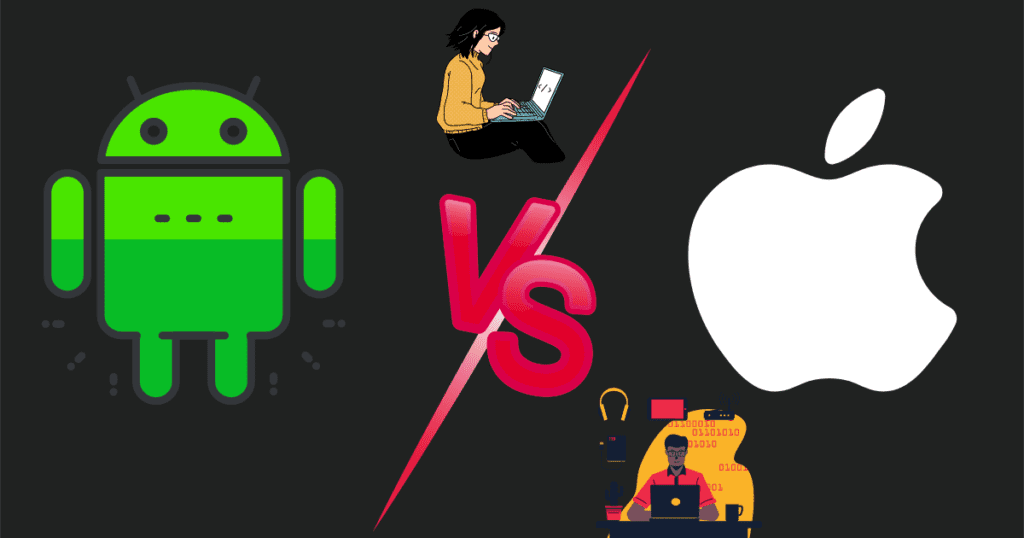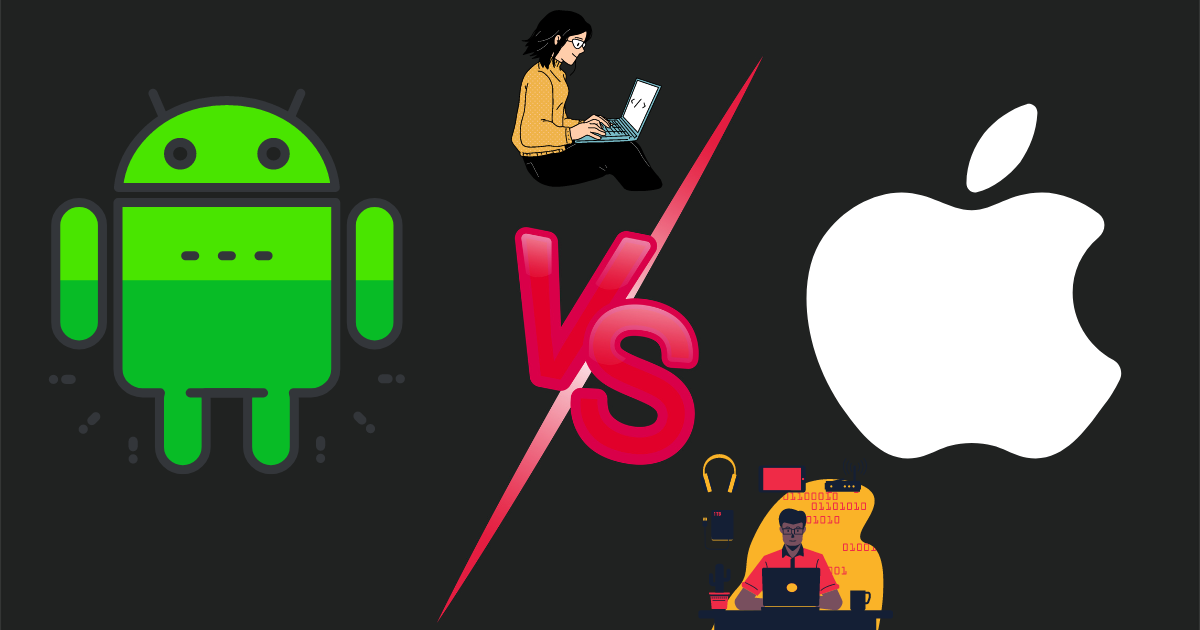In the ever-evolving landscape of mobile app development, the choice between Android vs iOS Development can significantly impact a developer’s journey. Each platform boasts unique features, challenges, and opportunities, making the decision-making process crucial. This article aims to explore the intricacies of Android vs iOS Development, covering technical differences, market share, user interface design, and more.

Introduction
Mobile app development has become synonymous with two major players: Android and iOS. As developers navigate the vast realm of possibilities, understanding the nuances of each platform becomes paramount. Let’s embark on a journey to dissect the key aspects that differentiate Android vs iOS Development.
Technical Differences Between Android and iOS
Programming Languages
Android Development predominantly involves Java and Kotlin, providing developers with flexibility and versatility. On the flip side, iOS Development relies on Swift and Objective-C, emphasizing performance and efficiency. The choice of programming language can significantly influence a developer’s approach and the overall development process.
Device Fragmentation on Android
One of the distinctive features of Android is its open-source nature, which contributes to device fragmentation. Unlike the closed ecosystem of iOS, where devices are limited to Apple products, Android spans a multitude of manufacturers and models. This diversity poses challenges for developers aiming to create apps that seamlessly adapt to various screen sizes and specifications.
Integrated Development Environment (IDE) Variations
Android developers commonly utilize Android Studio, a robust and feature-rich IDE. In contrast, iOS developers work with Xcode, Apple’s integrated development environment. Each IDE has its strengths and features, impacting the development workflow and efficiency.
User Interface Design
Material Design on Android
Android follows Google’s Material Design principles, focusing on a clean and intuitive user interface. Material Design promotes responsive animations, grid-based layouts, and a consistent design language across different devices. Developers on Android are encouraged to create visually appealing and user-friendly interfaces that adhere to these guidelines.
Human Interface Guidelines on iOS
iOS, on the other hand, adheres to Apple’s Human Interface Guidelines (HIG), emphasizing a minimalist design approach. The HIG provides a set of principles and recommendations for designing a cohesive and aesthetically pleasing user experience across iOS devices. Developers need to align their design choices with these guidelines to create apps that seamlessly integrate into the iOS ecosystem.
User Experience Considerations for Each Platform
Beyond the technicalities, developers must consider the preferences and behaviors of their target audience. Crafting an engaging user experience involves understanding the expectations and habits of Android and iOS users. Tailoring the interface to suit the platform’s guidelines ensures that users feel comfortable and familiar with the app’s navigation and design.
Market Share and Demographics
Global Distribution of Android vs iOS Users
When it comes to market share, Android has a broader global distribution due to its availability on a wide range of devices. Android caters to a diverse demographic, spanning various income levels and geographical locations. Developers need to factor in this diversity when creating apps for Android, considering the varied needs and preferences of a global user base.
Target Audience Considerations for Developers
Understanding the demographics and preferences of the target audience is pivotal. iOS users tend to be more concentrated in higher-income brackets, making them potentially more lucrative for certain types of apps. Developers need to align their target audience with the strengths and limitations of each platform to maximize the app’s reach and impact.
App Distribution and Monetization
Google Play Store vs Apple App Store
App distribution is a critical aspect of the development process. Android apps are distributed through the Google Play Store, known for its openness and a less stringent submission process. On the other hand, iOS apps undergo a thorough review process before being made available on the Apple App Store. Developers need to be aware of the submission requirements and guidelines for each platform to ensure a smooth distribution process.
Revenue Models and Monetization Strategies
Monetizing apps is a key consideration for developers. Both Android and iOS offer opportunities for revenue generation through various models, including in-app purchases, advertisements, and subscription services. However, the revenue potential may vary based on the target audience and the nature of the app. Developers should carefully strategize their monetization approach based on the platform’s user behavior and preferences.
Development Time and Cost
Timeframe for Android Development
The development timeline for Android apps can vary due to factors such as device fragmentation and testing requirements. Developers may need to allocate additional time for optimizing their apps for different screen sizes and resolutions. Balancing efficiency with thorough testing is crucial to delivering a seamless user experience on a diverse array of Android devices.
Cost Factors Associated with iOS Development
Developing for iOS may incur higher initial costs due to the need for Apple hardware and adherence to specific guidelines. While iOS development is often considered more streamlined due to a narrower range of devices, the upfront investment can be a significant consideration for developers with budget constraints. Careful budgeting and resource planning are essential to navigate the potential cost implications.
Security and Privacy
Security Measures on iOS
iOS has gained a reputation for its robust security measures, providing users with a secure environment for their data. Apple’s closed ecosystem, stringent app review process, and focus on user privacy contribute to the platform’s strong security foundation. Developers on iOS benefit from a secure framework that instills trust among users.
Open-Source Nature and Security Concerns on Android
In contrast, Android’s open-source nature introduces a level of flexibility but also raises security concerns. The diverse range of devices and the decentralized nature of the platform can make it challenging to enforce consistent security measures across the ecosystem. Developers must be vigilant in implementing security best practices to mitigate potential vulnerabilities.
Updates and Fragmentation
Timely Updates on iOS Devices
One of the advantages of the iOS ecosystem is the simultaneous release of updates across devices. This ensures that users have access to the latest features, security patches, and improvements. Developers on iOS can leverage the latest technologies and APIs with the confidence that a significant portion of the user base will have prompt access to these updates.
Challenges with Android Device Fragmentation
Android’s device fragmentation poses a notable challenge when it comes to ensuring timely updates for all users. The availability of updates is contingent on device manufacturers and carriers, leading to a varied and sometimes delayed adoption of the latest Android versions. This fragmentation can impact developers’ ability to leverage new features and technologies uniformly across the Android user base.
Community and Support
Android vs iOS Development Community
The size and engagement of the developer community play a crucial role in the development journey. Android, being an open-source platform, has a vast and diverse developer community. The abundance of resources, libraries, and forums can be beneficial for troubleshooting and collaborative projects. On the other hand, iOS developers benefit from a more curated and focused community, providing a different set of advantages in terms of specialized support.
Support and Resources Available for Developers
Both Android and iOS platforms offer extensive documentation, forums, and support channels for developers. Choosing between the two involves assessing the developer’s preference for community dynamics and the specific resources needed for the project. While Android provides a wealth of open resources, iOS offers a more curated and Apple-supported environment.
Choosing Between Android and iOS
Factors to Consider
The decision to develop for Android or iOS hinges on various factors. Developers must consider the target audience, project requirements, and personal preferences. Android’s flexibility may appeal to those seeking customization, while iOS’s closed ecosystem and streamlined development process may attract developers valuing a curated and controlled environment.
Decision-Making Process for Developers
To aid in the decision-making process, developers can follow a structured approach. Assessing the project’s scope, target audience, and desired features will help in determining which platform aligns better with the development goals. Considering long-term plans and potential scalability issues is essential for making an informed decision.
Case Studies
Success Stories on Android
Examining successful apps on the Android platform provides valuable insights. Apps like WhatsApp and Instagram showcase the global reach and adaptability of Android. Analyzing the strategies employed by these success stories can inspire developers and inform their decisions.
Notable iOS App Achievements
On the iOS front, apps like TikTok and Airbnb have achieved remarkable success. These apps highlight the lucrative opportunities within the iOS ecosystem and the potential for global recognition. Developers can draw inspiration from these success stories while being mindful of the unique challenges and requirements of iOS development.
Future Trends in Mobile Development
Emerging Technologies for Android
Looking ahead, Android developers can anticipate emerging technologies shaping the future. The integration of augmented reality (AR), artificial intelligence (AI), and 5G connectivity presents exciting possibilities. Staying abreast of these trends allows developers to position their apps at the forefront of innovation.
Apple’s Roadmap for iOS Development
Apple’s roadmap for iOS development includes continuous improvements to user privacy, app performance, and developer tools. Understanding Apple’s plans enables developers to align their strategies with upcoming features and changes in the iOS ecosystem.
Conclusion
In the dynamic landscape of mobile app development, the choice between Android vs iOS Development is a pivotal decision. Both platforms offer unique opportunities and challenges, and the decision should align with the goals and preferences of developers. Whether opting for the flexibility of Android or the streamlined ecosystem of iOS, the key is to create a seamless and engaging user experience.
FAQs
- Is Android development more challenging than iOS development?
- The complexity of development depends on factors like programming languages and device fragmentation. Both platforms present unique challenges that developers must navigate.
- Which platform is more lucrative for app monetization?
- The revenue potential varies, with factors like target audience and monetization strategies playing a significant role. Both of these platforms offer great opportunities for developers to generate revenue.
- How often do Android and iOS release updates?
- iOS devices receive simultaneous updates, ensuring a consistent user experience and the prompt adoption of new features. Android updates, however, may be subject to device fragmentation, leading to varied adoption rates.
- What role does the developer community play in choosing a platform?
- The size and engagement of the developer community influence the availability of resources, support, and collaborative opportunities. Developers should consider their preferences for community dynamics when choosing a platform.
- Can a developer create an app for both Android and iOS simultaneously?
- Yes, cross-platform development tools allow developers to create apps compatible with both Android and iOS. This approach streamlines the development process, enabling the app to reach a broader audience.
Also Read:
